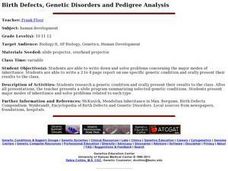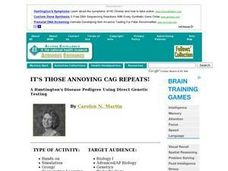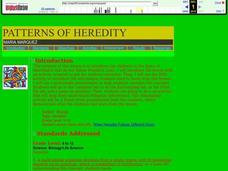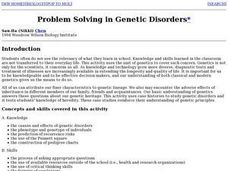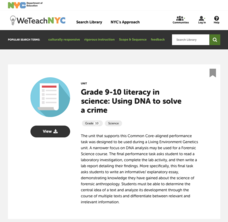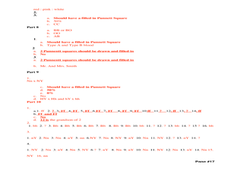Curated OER
Take Home Lab: What Are Some Traits in Your Family?
Learners use this following the study of pedigree designs and human genetics. Four pedigree designs are prepared of your (student's) family's genetics. They construct the pedigree representing two, three, or four generations.
Curated OER
Family Traits
Students investigate the study of pedigree designs and human genetics. They construct the pedigree representing two, three, or four generations. They investigate their family members' traits for ear lobe attachment, tongue rolling,...
Howard Hughes Medical Institute
Pedigrees and the Inheritance of Lactose Intolerance
What, exactly, causes lactose intolerance? Scholars view a video describing a Finnish study that determined why some people are tolerant while others are intolerant. They then use the data from the study to reenact the experiment and...
Curated OER
The Value of Genetic History
Students research and assemble their own pedigrees using star patterns for each family member and coloring in various dominant traits. They arrange these patterns on long strips of paper making large, colorful family pedigrees.
Curated OER
Adaptations to Niches and Habitats
Life science learners measure and record traits of seeds, leaves, and their own hands and then graph the data to find a continous distribution curve. They compare and color diagrams of seven different animals' forelimbs (not included),...
Curated OER
The Human Genotype
Six different chromosome activites introduce biology aces to heredity, chromosomal abnormalities, sex-linked traits, and the human genome. The hands-on activites are fairly simple for the teacher to prepare and will prove to be both...
Curated OER
Take Me to Sesame Street!
Pupils will apply concepts learned in genetics, such as Punnett squares and pedigree charts, in creating their own monster family. Also they will work cooperatively with a partner to create their monster family.
Curated OER
Genealogy Research
Personalize history through genealogy. Get your scholars examining their family's past by utilizing resources at your local genealogical society. Learners complete family pedigree charts and choose to do one of the following: research...
Curated OER
So Whose Cow is in the Field?
Pupils, in rural classrooms, explain animal genetics. They study animals that are available in their locale.
Curated OER
Birth Defects, Genetic Disorders and Pedigree Analysis
Pupils write down and solve problems concerning the major modes of inheritance. They research a genetic condition and orally present their results to the class.
Curated OER
The Genetic Diagnosis of Cancer: The Questions Continue to Multiply
Students review the basic concepts of genetics, such as Mendelian inheritance and pedigree construction and analysis. They use an activity that uses recent findings in cancer genetics to present. Students use a pedigree in a "real...
Curated OER
Huntington's Disease
Students research specific genetic disorders and create a pedigree of a fictitious local family in which Huntington's Disease is found. They predict inheritance and severity of HD and role play decision making process involving genetic...
Curated OER
Biology-Genetics
High schoolers predict the probable mode of inheritance from a pedigree diagram showing phenotypes. They study the genetic basis for Mendel's laws of segregation and independent assortment. They give a Power Point slide show...
Curated OER
Gene Puzzles
Students come to understand that in sexually reproducing organisms, such as humans, typically half of the genes come from each parent.
Students examine a fictional pedigree and determine which gene is responsible for a given trait. The...
Curated OER
Patterns of Heredity
Students describe the differences between incomplete dominance and codominant alleles, and between multiple alleles and polygenic inheritance. They describe how internal and external environments affect gene expression. They then...
Curated OER
Problem Solving In Genetic Disorders
Students explore the causes and effects of genetic disorders. They examine the phenotype and genotype of individuals and predict the recurrenence risks. Students generate a Punnett square and construct pedigree charts.
Personal Genetics Education Project
Scientific Themes in Personal Genetics
Humans can be tested for the presence of the BRCA gene, whose presence is an indicator that they have a greater chance of acquiring breast cancer than someone without the gene. Viewers have an opportunity to explore how genes and...
New York City Department of Education
Grade 9-10 Literacy in Science: Using DNA to Solve a Crime
Scholars become detectives and use science to solve a crime! A complete unit introduces DNA and includes hands-on activities that have learners model DNA and extract it from different food types. A culminating activity challenges...
Curated OER
The Electrophoresis of Human Hemoglobin
High schoolers are presented with a scenario that requires them to electrophoreses human hemoglobin samples in order to confirm a diagnosis of sickle cell anemia and/or to determine whether individuals in the scenario are carriers of the...
Curated OER
Creating A Family Tree
Fourth graders explore their ancestral background while they experience genealogy.
Curated OER
Genetics Worksheet
In this genetics worksheet, learners answer a variety of questions about genotypes, phenotypes, genetic inheritance, and traits. They solve for the probability of genotypes and phenotypes of offspring by completing monohybrid and...
Curated OER
Human Genetics
In this biology worksheet, 9th graders create a Punnett square to show the possible offspring of a carrier female and a normal male for color blindness. Then they draw a pedigree for the family and indicate whether the daughter is...
Curated OER
Heredity Worksheet #4
In this genetics worksheet, students use a pedigree to determine if any of the offspring carry a recessive trait. This worksheet has 5 fill in the blank and 5 short answer questions.
Curated OER
Real Family Genetics
Learners research genetic disease and mutation causing traits in family pedigrees simulated in a class activity. Students are each assigned a genetic trait and a "spouse" and must conduct research on their traits and the probability of...











